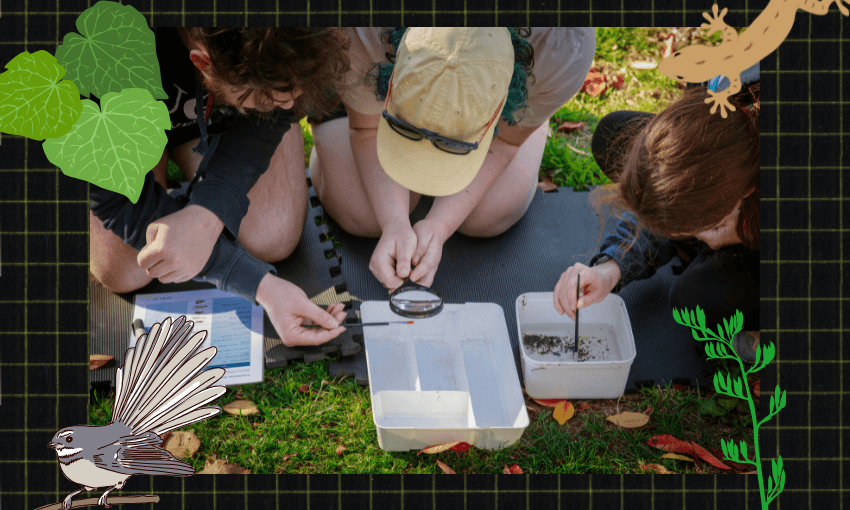Last year, 20,000 observations of Christchurch species were made during the annual City Nature Challenge, a way for anyone to get involved in biodiversity. It’s back again this month.
Even in suburbia, even on grey autumn weekends, there is biodiversity. You just need the time to look for it: to name the bird flapping through your backyard or identify a spider dangling from the corner of a shed or a frothy lichen growing across a park bench.
Citizen science is the process of involving people in gathering information about what is around them, without requiring that they be specially trained experts. It’s the focus of the City Nature Challenge 2025, which is happening this April in New Zealand. Wellington, Christchurch and New Plymouth are participating, with city councils or local biodiversity groups getting residents involved. It’s a nice reminder that the fun of exploration isn’t limited to people who have the budget to travel over school holidays or long weekends, but is accessible to all.
The City Nature Challenge happens via iNaturalist, a website and app that allows members of the public to identify species in the wild. The “challenge” part comes in via leaderboards displaying running tallies of the number of observations and species per city. Paired with location data and lots of experts who check the results, iNaturalist has been used to discover moth species previously thought to be extinct and can help environmental experts figure out what species are in an area when approving resource consents.
While iNaturalist observations can be done anywhere, the City Nature Challenge highlights urban biodiversity. Never mind that you’re not exploring a tropical rainforest or encountering penguin colonies in the Ross Sea: even on a cold autumn weekend in the city, there is biodiversity around you.
“It’s a global revolution in biology around the world,” Jon Sullivan, who operates the iNaturalist New Zealand “node”, told The Spinoff in 2022. Sullivan, an ecology lecturer at Lincoln University, had some of the most observations in last year’s challenge. He spotted 720 species over four days, his cycle commute from Christchurch to Lincoln forming a line of biodiversity on the map.
This year, he’s leading a free walk from the Sign of the Takahē in the Port Hills to the Botanic Gardens, with stops to notice nature along the way, part of a string of events encouraging people to get involved. If your interests lean more towards observing miniature things, then there will be soil scientists at the Climate Action Campus in Avonside to demonstrate how you can find critters that live in the ground. Morgane Merien, a scientist who works at Canterbury Museum, is hosting drop-in sessions at libraries with live insects and specimens for people to look at as they learn to use iNaturalist.
The challenge is right at the end of the school holidays and open to everyone – not just kids or ecologists. But iNaturalist can be used at any time of the year, and could be a particularly good close-to-home activity for parents wanting to learn more about the environment with their kids.
It is particularly motivating to record species observations at the same time as others, though. In Christchurch, more than 20,000 observations were made of different species during last year’s City Nature Challenge, and more than 2,245 different species were spotted.
“Every new observation paints a picture of what’s living here in Ōtautahi Christchurch, and the more we know, the more we understand,” says Sarah Mankelow, a community partnership ranger at Christchurch City Council.
Observations gathered during the event are a valuable reflection of environmental conditions. In 2023, more than 30 basket fungi were observed, with their spindly white structures distinct on the ground. 2024 was much drier: very few fungi were observed, and no basket fungi at all. “The big signal that is clear from the 2024 data was how nature responded to the long, hot, dry summer we had,” Mankelow says. The most common species spotted was tī kouka, cabbage trees, their distinctive sprouty leaves easy to identify and log.
The competitive element to the challenge is a helpful impetus to get people out of doors. Cities compete against each other, too: Christchurch’s 20,000 observations in 2024 beat Wellington’s 18,000 observations, although Wellington won out the year before. Even if you’re not in a city that’s taking part, your observations can count towards Aotearoa’s overall score.
The prize, of course, is the satisfaction of contributing to science and feeling newly aware of the living things around you, but Mankelow does have some tips for people who want to get their numbers up. “Coastal rock pools are often overlooked but are good places to look for concentrations of animals. Areas of long grass are often home to lots of invertebrates, so good places are also the edges of parks and in the red zone where we are letting nature do its thing – particularly around Bexley and Waikakariki Horseshoe Lake,” she says.
Christchurch City Council and its park rangers are trying to improve biodiversity with tree planting and pest control. But the City Nature Challenge is a way to invite people to improve biodiversity in their own backyards, too. Planting natives like harakeke and kōwhai, which provide food for birds, is a good bet. Plants like kānuka and mikimiki provide safe coverage for lizards and mowing the lawn in squiggly lines means the grass at the side is longer – more habitat for insects.
“Biodiversity isn’t just something for the experts,” Mankelow says. With the City Nature Challenge, everyone can find something amazing and alive.
